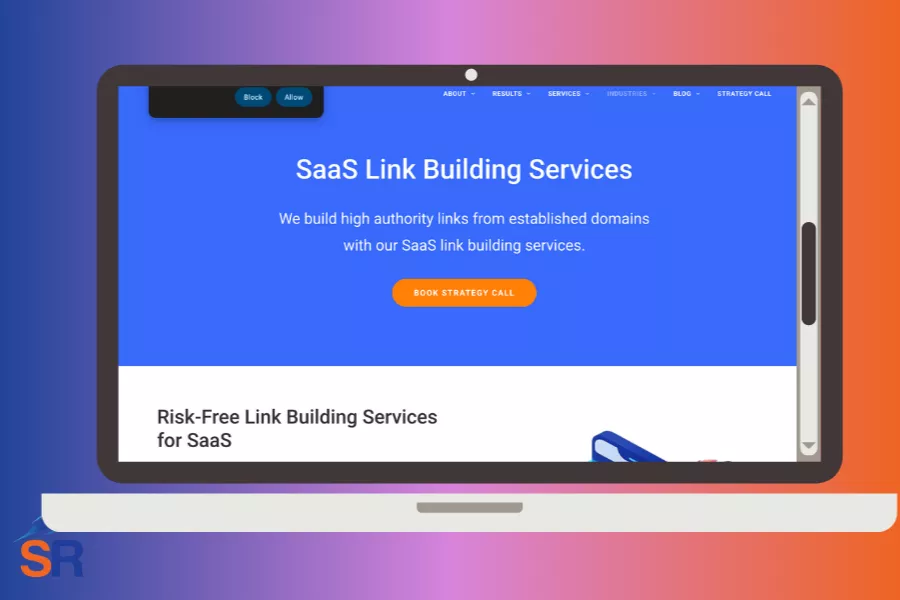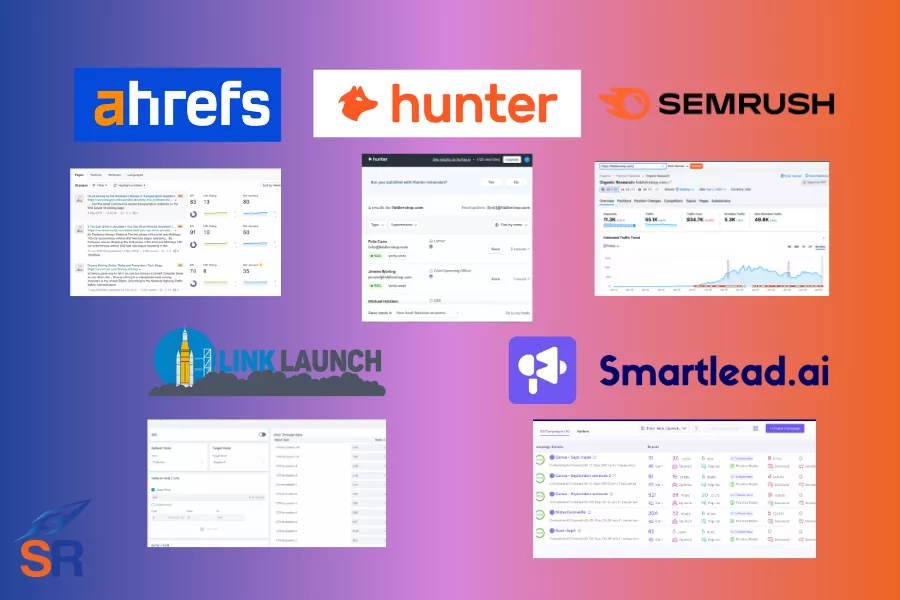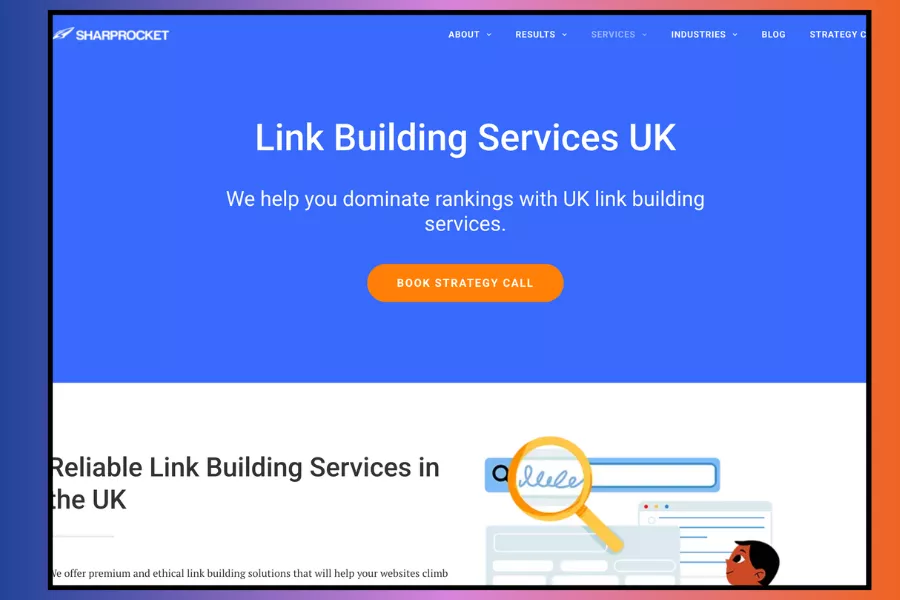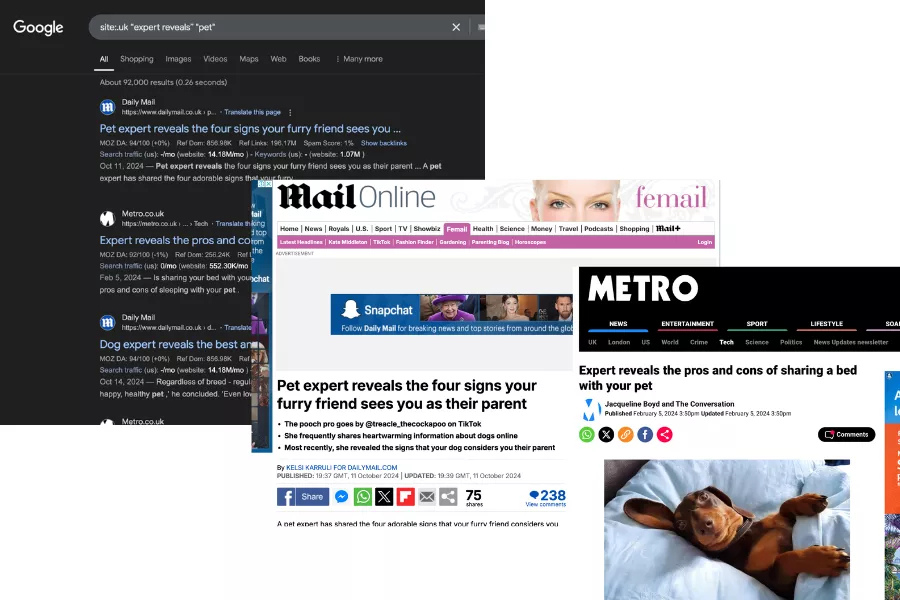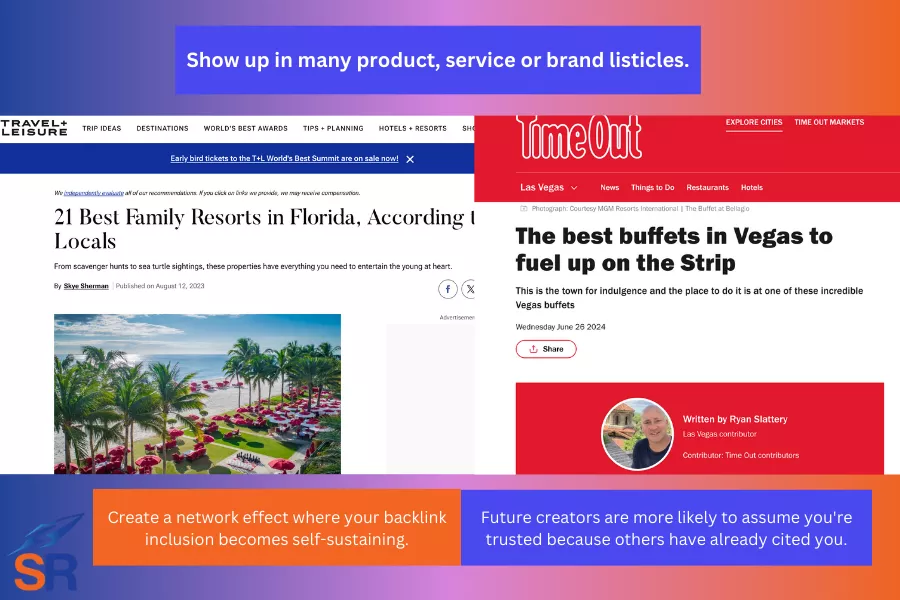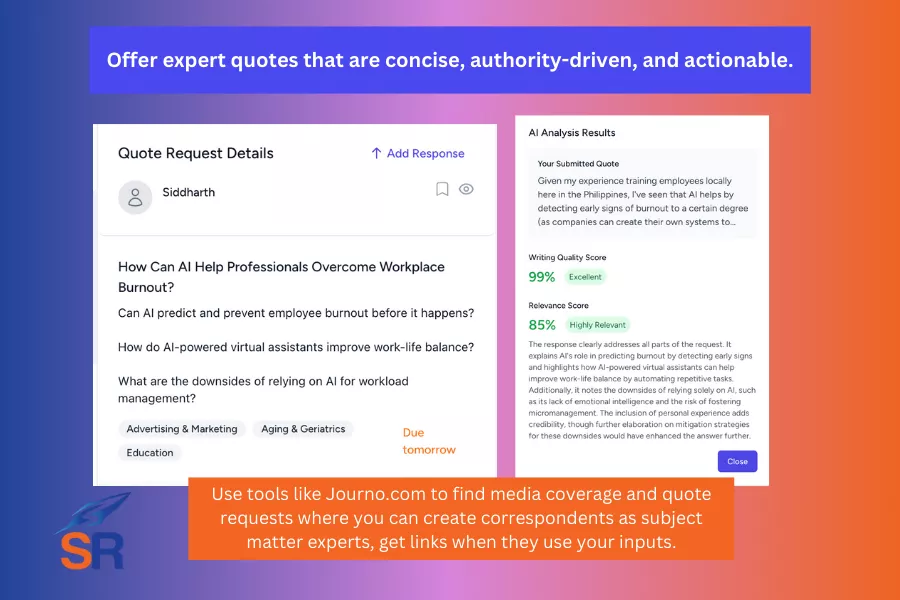Backlinks are still undeniably the strongest signals in ranking websites these days- as links no longer just count as votes of confidence, but also as contextual signals that support entity recognition, citation, and even AI-driven indexing.
In an attempt to outcompete big brands in many industries, most SEO specialists would try to influence their website rankings by aggressively building links at an unnatural pace that doesn’t match the site’s authority or age, which is not only questionable but highly vulnerable to algorithmic devaluation or manual penalties.
This is where understanding the concept of link velocity comes in—learning why it matters and how to manage it so that it works for you, not against you.
Contents
ToggleWhat is Link Velocity?
Link velocity is the speed at which a website gains new backlinks over a specific period (daily, weekly, or monthly), giving data on how fast a site’s backlink profile is growing.
How fast should you be building backlinks?
You should build backlinks at a natural pace that aligns with your site’s authority, age, and content publishing frequency. For new websites, 5 to 10 high-quality backlinks per month is a safe range. Older, more established sites can earn links, especially if supported by fresh content, linkable assets, and a strong brand reputation.
The Myth of “Faster Is Better”
Getting backlinks at an unusual rate (“fast” but careless) without actual context and control can signal attempts to manipulate rankings.
Here are some scenarios where faster link building becomes a problem, especially when no real-world context justifies the upward trend or spike.
Getting Irrelevant and Types of Links That Don’t Matter Anymore
Topical relevance is a strong indicator of a link’s value. In contrast, acquiring irrelevant links from websites of weaker domain authority can dilute your site’s trust profile and confuse search engines about your site’s content theme.
Below are the types of links that are considered to be devalued:
- PBNs, especially multi-category blogs without niche relevance (and which are linking to each other).
- Hacked links – inserted random links into other sites’ existing content.
- Forum and comment spam links – irrelevant/spam links in forums as part of signatures
- Low-quality directories – scalable submission of profiles to spammy directories
- Irrelevant link exchanges – doing a link exchange from a completely unrelated website
Off-topic and uncontextual backlinks from irrelevant sources add noise to your site’s backlink profile and weaken its branding and reputation.
Unusual Anchor Text Variations
An interesting study by Cyrus Shepard shows that actual text variations in links correlate well with search traffic and that sites with more anchor text variety get better search performance. Conversely, sites with unvaried anchor text links tend to lose search traffic.
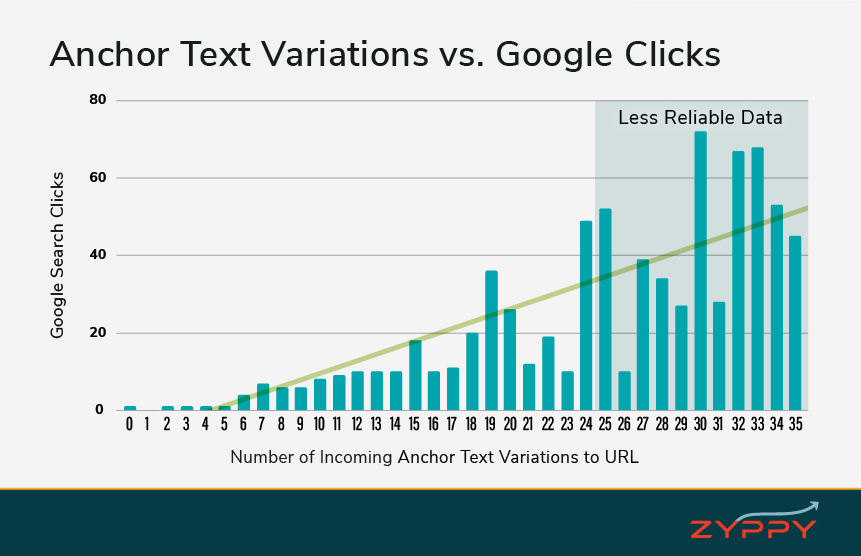
At one extreme end of the pendulum, savvy SEOs are trying to game the link building system with high variations of anchor texts. While this approach is strategic and with a positive intent to naturalize their sites’ backlink profiles, it could spell trouble if the majority of the links are filled with partial, and exact match anchors.
In addition, when links are acquired at unnatural link velocity with over-manipulated anchor texts, search engines may be signaled of any manipulation. The unusual link spikes make strategic anchor text optimization less likely to achieve favorable results in rankings and search traffic.
For better anchor text variety, you can check out our guide on how to optimize anchor texts.
Aggressive Link Volume That Doesn’t Match Content Publishing Frequency
Content publishing frequency on your site is often ignored when talking about link velocity, given that the lens is more focused on the external link building efforts than on the quality and volume of content assets published on the website.
When link volume grows without a clear content-based trigger—e.g., publishing new pages, content updates and upgrades to existing pages, and other internal branding efforts—it may actually signal artificial link building.
And to think that it is very unusual for any brand to consistently get new links without consistently updating its own content library.
Safe Link Building Practices to Manage Link Velocity
Here are actionable ways if you want to take safety measures when building backlinks to your site:
Natural Link Acquisition at Scale
The penalty triggers occur more often for sites that heavily involve manual link building methods, such as guest blogging, link insertions, profile creation, etc.
The reverse—natural link acquisition, where you invest in linkable assets that passively acquire links independently, is the safest link building practice to pursue.
When you get backlinks naturally, your methods highly depend on the quality of helpful content on your site and the strategy to get more eyeballs for these pages, which will increase the chances they’ll become more visible to target publishers.
Publish more linkable assets that naturally attract links from publishers at their writing stage. Given that they will tend to search on Google to find resources they can reference in their content, and naturally link to your page to expound on terms they don’t want to define anymore.
Most natural links from ranking linkable assets for informational queries will form an upward trend for the site’s link data for referring domains, not sharp or suspicious spikes.
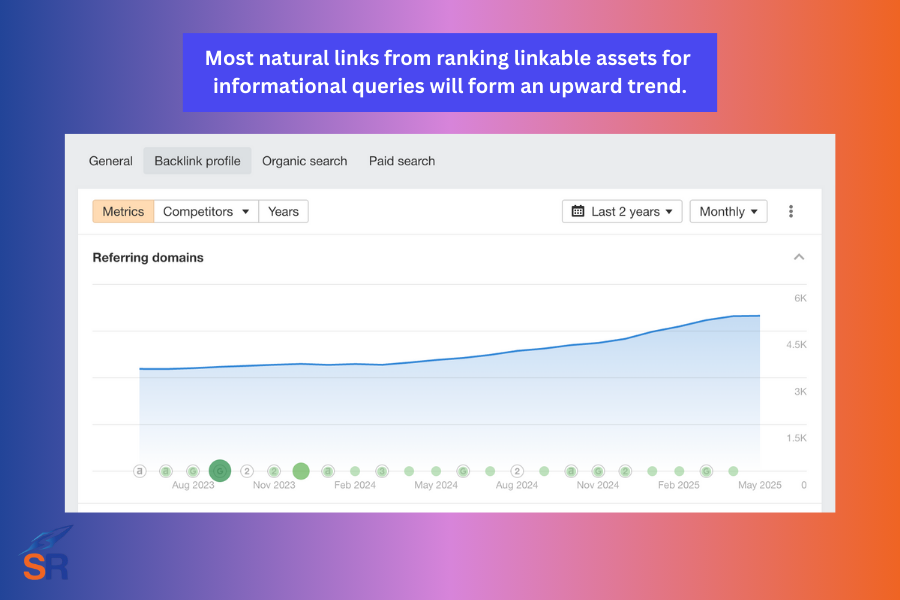
This pattern reflects a more natural backlink pattern, which you would typically find with most sites that have solid branding and reputation.
Match Link Building Efforts With Site Authority and Maturity
The best approach in managing link velocity is to anchor it to your site’s current level of authority and domain age.
Acquiring hundreds of backlinks in the first month, especially without investing in topical assets to build your site’s content library, looks unnatural. However, getting hundreds of links is more acceptable and often expected for established websites with higher domain age, currently ranking for industry keywords, and building foundational SEO work.
Recognize these maturity signals when deciding the volume of links and anticipating link velocity for your site:
- Growing library of topically related content.
- Increasing organic traffic and brand search volume (caused by the brand’s offline marketing efforts and growing interest from ranking information pages).
- Number of trusted links from highly authoritative domains (DR60+)
- Frequent updates on the product or landing pages
Given that search engines evaluate context, not just raw numbers, matching your link velocity to your site’s stage of development protects against penalties and sustains long-term rankings.
Pro Tip: Ramp up your link building efforts for new websites slowly – and as it gains more organic traffic from rankings, you can gradually increase links.
Use an Anchor Text Cycle Instead of Obsessing Over Ratios
Monitoring anchor text ratios is often a standard approach to managing link velocity and reducing the tendency to get penalized. However, micromanaging percentages can become rigid and resource-intensive, especially if you’re managing several web properties or clients’ websites.
A more flexible, straightforward approach is using the anchor text cycle.
The main idea is using rotating anchor text types month after month, instead of trying to hit perfect ratios – this reflects how natural link profiles develop their backlink profiles – gradually, unevenly, and are influenced by different content sources.
For instance, when building backlinks for a new website, you focus on building exact-match anchors to increase your page’s topical relevance in the first month. Though it may seem contradictory, remember that building a single link doesn’t automatically penalize your site. Then, in your second month, you can focus mainly on acquiring branded anchors. The cycle continues until you reach a perfectly balanced anchor text profile.
Rotating anchor texts focus helps distribute your optimization efforts without creating suspicious, over-optimized patterns.
Distribute Link Equity Across Multiple Pages
Link diversity is a healthy approach to ensuring that your site develops a more natural backlink profile by spreading backlinks across different pages, ones you intentionally want Google to acknowledge as your most important pages.
Here are two essential ways to do more link diversity for your website:
- Attract more inbound links to your informational content assets (not just your landing pages) by promoting them to target interested linkers (publishers, bloggers, journalists, etc) – seeing that a well-built online brand typically also gets natural links to its informational pages.
- Use internal linking to pass link equity to deeper pages or pages you want to rank for. You can use Ahrefs to find top-linked pages and build internal links from them to topically relevant but less internally linked pages.
Focus on Quality and Brand Association
While “quality over quantity” is standard SEO advice, it’s often overlooked in practice for many SEO audits I’ve conducted for numerous clients’ websites.
Earn and build the types of backlinks that truly reflect your brand’s reputation.
A couple of tips to help you lean on backlink quality even more:
- During the link prospecting stage, ask yourself, “Would I want my brand mentioned on this site even if SEO didn’t exist?”.
- Set a list of link metrics your SEO team or outsourced link building agency will follow to ensure quality for backlinks.
- Prioritize providing value to more, but trusted, authoritative domains using different link building strategies and value-driven link outreach angles.
- Think long-term sustainable link building instead of a one-time off approach to chasing links.
Resilient Backlink Profile That Scales Safely
Focus on natural link acquisition, anchor text cycle, and aligning your link building efforts with your site’s growth stage to create a resilient SEO foundation. There is nothing safer than positioning your link building campaigns as a branding effort instead of another chase to game the system.
If you’re looking for more sustainable link velocity, explore our link building services and see how we can help.
Written By
Venchito Tampon
CEO and Co-Founder at SharpRocket, a link building agency. With a decade of experience, Venchito has a proven track record of leading hundreds of successful SEO (link builidng) campaigns across competitive industries like finance, B2B, legal, and SaaS. His expert advice as a link building expert has been featured in renowned publications such as Semrush, Ahrefs, Huffington Post and Forbes. He is also an international SEO spoken and has delivered talks in SEO Zraz, Asia Pacific Affiliate Summit in Singapore, and Search Marketing Summit in Sydney, Australia. Check out his other business - Hills & Valleys Cafe.
Reviewed By

Sef Gojo Cruz
COO at SharpRocket, overseeing end-to-end operations, from crafting link building strategies to leading high-performing teams. Previously led SEO initiatives at Workhouse, a digital agency in Australia, and Keymedia, a real estate media company based in New Zealand.
How our LINK BUILDING AGENCY in UK builds 250 links/mo consistently using Predictable Link Building Methodology™…
- Using a SIMPLE and PROVEN system
- Using a SCALABLE strategy
- No private blog networks
- No creepy outreach emails

